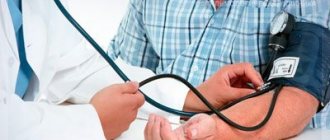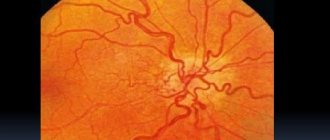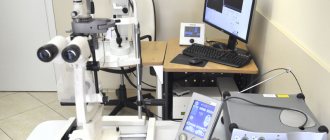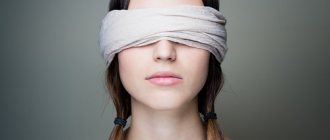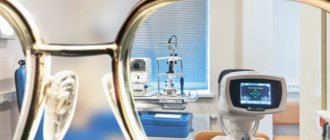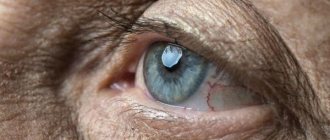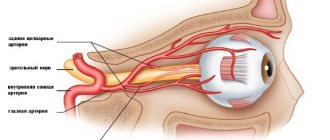- June 22, 2018
- Ophthalmology
- Nikita Ilyushenko
Vision is one of the most important human senses, and it is what people most often use to perceive any information about the world around them. Naturally, in real life, all senses work synchronously, complementing each other, but loss of vision has the greatest impact on a person’s ability to work and well-being. Accordingly, it is vision that people need to take care of most of all, especially considering the huge number of diseases that now exist related to the eyes. One of them will be discussed in this article.
Angiopathy as a very dangerous eye disease
You will learn about what hypertensive retinal angiopathy is, what this scary-sounding disease threatens, how to deal with it and how to prevent its occurrence. This is very useful information, since it is in the modern world that this disease begins to appear more and more often. Accordingly, you need to learn as much as possible about what hypertensive retinal angiopathy is so that, if necessary, you can fight it as effectively as possible.
What it is?
Retinal angiopathy of the hypertensive type is a disease that occurs most often in those people who already suffer from hypertension. This disease manifests itself when you have been suffering from hypertension for a long time, because of which the vessels in your eyes begin to suffer, they gradually change, negatively affecting the retina of your eye. This disease is known for the fact that it can be found in people of absolutely all ages, but most often it manifests itself in middle-aged people. It is also worth mentioning that it is extremely rare that retinal angiopathy of the hypertensive type develops in one eye. Its distinctive feature is that it almost always develops in both eyes at once, affecting both retinas.
Signs of hypertensive retinopathy
A complex change in the condition of the retinal vessels (angiopathy) in hypertension, accompanied by a persistent increase in blood pressure in ophthalmology is usually called hypertensive retinopathy. Hypertensive retinopathy is one of the most commonly identified complications of high blood pressure. It is manifested by severe hemorrhages and exudate in the fundus, in some cases, swelling of the optic nerve.
Often the disease is virtually asymptomatic. In the later stages of its course, a significant decrease in visual acuity is noted.
Hypertensive retinopathy can occur in people of any age and gender, but is especially common among older people and people with high blood pressure (including hypertension due to kidney and adrenal disease).
Why does this disease occur?
To put it as simply as possible, so that any reader, even one who does not understand medicine, can understand, hypertensive angiopathy is a complication of a more extensive disease, which has already been mentioned earlier. Hypertension comes with a large number of possible complications, among which is the disease discussed in this article. Thus, retinal angiopathy of the hypertensive type in both eyes occurs due to the fact that blood pressure in the body is almost always elevated, which affects the vessels in your eyes. As is known, normalization of blood pressure in the vessels of a person with hypertension occurs much more slowly, in some cases up to five times slower. These vessels also include the ophthalmic artery, which suffers from this disease, thereby leading to the development of angiopathy, which is what we are talking about now.
Causes of retinal angiopathy
Frequent increases in pressure have a detrimental effect on the retina of the eye, affecting the walls of blood vessels from the inside. The walls of blood vessels thicken and become fibrotic. Blood circulation is disrupted, blood clots form, blood vessels begin to burst in the eyes, which can lead to hemorrhage in the retina. A characteristic sign of hypertensive angiopathy is narrow tortuous vessels of the fundus.
Diabetes mellitus, or rather a constant excess of glucose in the blood, leads to inflammation of the vascular walls of not only the retina, but also the blood vessels of the whole body. With diabetes mellitus, blood leaks into the retinal tissue, the walls of the capillaries thicken, the diameter of the vessels decreases, and the speed of blood flow slows down. All this can lead to partial loss of vision.
Low pressure causes the retinal vessels to dilate and reduce their tone. Therefore, the speed of blood flow slows down, blood clots form, and the permeability of the vessel walls increases. With retinal angiopathy caused by hypotension, patients often complain of strong pulsation of the ocular vessels.
Injuries to the eyes, skull and spine can also lead to damage to the blood vessels of the eye. With prolonged compression of the chest or neck, intracranial pressure increases, which in turn negatively affects the blood vessels of the eyes. Severe injuries most often lead to rupture of the vascular walls of the retina and the appearance of hemorrhages in the eye.
It is still not entirely clear under what conditions juvenile angiopathy . Frequent manifestations of this pathology are an inflammatory process in blood vessels and hemorrhages in the retina. This leads to glaucoma, cataracts, retinal detachment and eventually blindness.
Atherosclerotic processes in the body provoke the formation of atherosclerotic plaques in the vessels and narrowing of the lumen in the capillaries. If there is insufficient blood flow, all organs and tissues lack oxygen, and ischemia develops. The pressure in the vessels increases greatly, which can lead to their rupture.
Factors contributing to retinal angiopathy:
- acute and chronic poisoning;
- some diseases of the hematopoietic system;
- bad habits (smoking, alcoholism);
- elderly age;
- osteochondrosis;
- congenital anomalies of the walls of blood vessels;
- systemic vasculitis;
- pregnancy.
1 Structure of the eye and eyeball
2 Diagnosis and treatment of scleritis
3 Treatment of scleritis
Stages of the disease
Each disease has its own stages, which differ in specific symptoms and other indicators. Retinal angiopathy of the hypertensive type (OU) is no different from other diseases; in this case, there are three stages that you should know about. The first stage is almost imperceptible; during it, a disruption of blood circulation in the vessels of the eye begins, but it is not very noticeable, so it is simply impossible to determine the occurrence of the disease. To do this, you need to purposefully examine the fundus of the eye with an ophthalmologist, and if you do this, you can save yourself from a lot of problems. In fact, if you suffer from hypertension, then you should take care of all aspects of your health, including your eyes, by periodically checking your vision. This is the only way to prevent retinal vascular angiopathy of the hypertensive type. However, we will talk about prevention a little later; now it’s worth looking at the remaining two stages of the disease.
At the second stage, seals appear in the blood vessels of the eyes, which causes a serious disruption of the blood supply to the retina. At this stage, the presence of the disease can already be seen with the naked eye. As for the third stage, it is better for you not to reach it under any circumstances. If you see that you have already developed signs of the second stage of the disease, consult a doctor immediately, since the third stage can lead to complete loss of vision due to exudate that forms at the bottom of the eyeball.
So now you know what it is. Retinal vascular angiopathy of the hypertensive type is a disease that definitely should not be joked with. However, if you do experience it, you should carefully read the other half of the article, devoted to its diagnosis, symptoms and treatment.
Clinical manifestations of hypertensive macroangiopathy
This disease is treated by an ophthalmologist. Due to the fact that hypertensive angiopathy is a complication of hypertension, the patient should be regularly monitored by a therapist or cardiologist. They will correct blood pressure levels, which will improve the results of treatment by the ophthalmologist.
Clinical signs and symptoms of macroangiopathy directly depend on which vessels are affected. If the lower extremities are affected, the following occurs:
- impaired blood flow in the legs;
- severe pain syndrome;
- increased swelling.
The characteristic symptom will always be intermittent claudication. When a vessel is blocked by a blood clot, gangrene may begin.
If the blood vessels of the brain are damaged, the patient may experience signs of a stroke, transient ischemic attacks of the brain (this condition is called a short-term, reversible stroke).
The patient may begin to show signs of illness:
- memory impairment;
- headache;
- reversible focal coordination disorders;
- paresis.
The hypertensive form of macroangiopathy inevitably leads to the development of coronary heart disease. A hypertensive patient with heart pathology will experience shortness of breath, severe pain behind the chest, between the shoulder blades, especially after active physical activity.
The progression of the disease provokes poor tolerance to physical activity and frequent pain attacks that can appear spontaneously. The extreme manifestation of coronary disease will be acute myocardial infarction.
When macroangiopathy affects the kidneys during hypertension, edema, disturbances in water-salt balance, electrolyte metabolism, and chronic renal failure may begin.
Hypertension, as one of the most common cardiovascular diseases, has a negative impact on all organs and systems of the human body due to disruption of blood flow in small and large arterial trunks. Hypertensive retinopathy is a pronounced narrowing of the retinal vessels that occurs against the background of arterial hypertension. Symptoms of the pathology depend on the stage of the disease, and treatment involves long-term use of antihypertensive drugs.
Hypertensive angiopathy is one of the first visible manifestations of impaired arterial tone, therefore, if an ophthalmologist detects changes in the fundus, you should consult a therapist for examination and treatment of vascular pathology.
Diagnostics
Now that you know what it is, retinal vascular angiopathy of the hypertensive type may seem like a rather dangerous disease to you, and that’s good. This means that you will not turn a blind eye to it, but will act as soon as necessary. And when you see a doctor, the first step is diagnosis. To diagnose this disease, you need to see an ophthalmologist, who should examine the fundus of the eye. There is a place where the optic nerve enters the retina; this place normally looks like a dark, even spot. If you suffer from the disease described, and you begin to have problems with the blood vessels in your eyes, then this spot will not be even. Accordingly, if the spot has lost its shape, then it’s time for you to move on to the second step, that is, treatment. But before you consider this second step, you may want to take a closer look at the symptoms you should be on the lookout for.
Symptoms
Many people ignore obvious symptoms, not realizing that they signal a disease. Accordingly, if you do not want to lose your vision, you should pay attention to specific symptoms. If you begin to develop angiopathy, your vision will deteriorate slightly, and it will periodically become cloudy due to pressure changes in the body. Fatty spots may also appear on the eyes, and people suffering from myopia will notice that it begins to progress very quickly. Also symptoms are some things not related to the eyes, such as nosebleeds and gastrointestinal bleeding. You may also experience severe pain in your legs.
Treatment methods
A qualified approach to studying the condition of blood vessels is provided by the most common method - ophthalmochromoscopy. This examination allows using red light to determine changes that have occurred in the vessels due to hypertensive angiopathy.
To clarify the diagnosis, you may need an ultrasound, x-ray, Doppler scan or, to get the most complete picture, an MRI.
To identify hypertension, it is necessary to undergo a comprehensive examination. It must include:
- blood donation for general analysis, cholesterol, creatinine levels;
- determination of blood pressure;
- analysis of the body's response to the treatment undertaken.
A more detailed diagnosis of hypertension and macroangiopathy should be determined by clinical symptoms. Lesions of the blood vessels of the brain, as well as the cervical spine, require the use of MRI (magnetic resonance imaging), ultrasound (ultrasound).
To understand cardiac activity and analyze the condition of blood vessels, coronary angiography, echocardiography, and electrocardiography are used. Any renal changes can be seen using ultrasound, urinalysis, intravenous urography.
An extremely important stage of diagnosis is tracking vascular changes. The tactics of subsequent therapy will completely depend on the correct diagnosis and adequate assessment of blood flow disturbances.
Macroangiopathy is treated with pharmaceutical medications. For patients with this diagnosis, doctors prescribe medications that are aimed at lowering blood pressure.
Before starting treatment, it is necessary to find out the type of macroangiopathy. It is important to understand what disease led to this complication. After all, you first need to try to get rid of the cause of the pathological process, and only then fight it yourself.
The disease, which is expressed in the form of damage to blood vessels, is quite specific. Therefore, you should trust his treatment to experienced specialists. It is worth noting that therapy for macroangiopathy involves the use of laser technologies. Only modern clinics have such equipment.
In Russia, every year there are from 5 to 10 million calls to emergency medical care for high blood pressure. But Russian heart surgeon Irina Chazova claims that 67% of hypertensive patients do not even suspect that they are sick!
How can you protect yourself and overcome the disease? One of the many recovered patients, Oleg Tabakov, told in his interview how to forget about hypertension forever.
Treatment
Well, the most important thing to talk about in this article is treatment. Retinal angiopathy of the hypertensive type is a disease that was previously considered incurable and was simply taken for granted. However, in the modern world the situation has changed, and technological progress now makes it possible to treat much more complex diseases that were previously considered incurable. Accordingly, angiopathy can also be cured. Moreover, it is quite easy to do. The fact is that the cause of its occurrence is hypertension, that is, high blood pressure. Your doctor may prescribe medications that normalize your blood pressure, thereby reducing the strain on the blood vessels in your eyes. As a result, the problem will not develop and will gradually disappear. However, you should understand that you cannot eat pills, you will also have to change your lifestyle very much, in particular, you will have to greatly limit yourself in nutrition. There are a variety of diets that will allow you to reduce the stress on your heart and all the blood vessels in the body, including those in your eyes.
Treatment of the disease
Retinal angiopathy of the hypertensive type is a very serious disease and often leads to blindness, so you should not try to cure it at home yourself, but you must consult a specialist.
The doctor will conduct a thorough examination and make a diagnosis. As therapy, medications are prescribed that lower blood pressure, anticoagulants and medications that improve metabolic processes in the retina.
A complex of vitamins is also credited. It is imperative that each patient is given dietary nutrition, physiotherapeutic methods and folk remedies therapy.
Treatment of hypertensive retinal angiopathy is primarily aimed at treating the underlying disease, i.e. hypertension.
To improve the condition of the retina, the following is prescribed:
- Vasodilators are vasodilators that act primarily on the vessels of the brain and eye (Cavinton, Xavin, Stugeron);
- To eliminate hypoxia, inhalations with oxygen or carbogen are prescribed;
- To thin the blood and prevent thrombosis, antiplatelet agents are prescribed - acetylsalicylic acid Cardio, Detromb, CardiASK, Klopidex.
- To protect against free radicals - antioxidants - alpha-tocopherol, vitamin C, Veteron, Diquertin;
- Angioprotectors - Doxium;
- For the resorption of hemorrhages - the enzymes Wobenzym and papain.
Only an integrated approach can improve the condition of the retina. Without treatment of the underlying disease, be it hypertension or symptomatic hypertension due to renal pathology, retinal angiopathy will not go away on its own and will only get worse.
Physiotherapeutic methods
Hypertensive angiopathy responds well to physiotherapeutic treatment methods. For this, laser therapy and exposure to a magnetic field are widely used. Laser therapy is based on the use of optical radiation of red and infrared radiation in pulsed or continuous mode.
Benefits of the method
This method improves metabolic processes in the affected eye structures, and in combination with drug treatment helps preserve visual functions for a long time. The procedure will help relieve spasms and improve blood microcirculation.
Magnetotherapy is a physiotherapeutic method that is based on the effect of a magnetic field on the eyes. It relieves spasm, swelling, and has a resolving effect. Also, using this method, retinal photoreceptors are stimulated, microcirculation, metabolism and conductivity of retinal cells are improved.
Magnetic therapy is used for degenerative disorders in the retina, inflammation of the optic nerve, diseases of the retinal vessels and increased eye pressure.
ethnoscience
Naturally, for each disease, people have their own treatment methods. Sometimes they can be quite effective, but you still should not use them alone, and certainly not use traditional medicine without consulting a doctor. In the case of this disease, traditional methods can be very effective, since various infusions can help quickly clear blood vessels of congestion that forms there and provokes the development of the disease. For example, you can use a decoction of rowan or black currant fruit, but you should not use any of these decoctions without consulting your doctor. Again, traditional medicine should come first, and traditional medicine can be used as an additional remedy to improve the overall effect.
Prevention
And finally, it’s worth talking about prevention. Yes, this disease is quite easy to treat in the early stages, but it will be much better if it does not manifest itself at all. And this can only be achieved with the right lifestyle. The diet has already been mentioned above, so at this point it is worth noting the strain on your eyes, which is why the vessels are also loaded and become vulnerable. In the modern world, people spend most of their time on computers at work, then they sit on their phones on public transport, return home and find themselves in front of the TV. All this puts a lot of strain on your eyes, so it is recommended to reduce the amount of time spent looking at the screen to an acceptable minimum, and also do special exercises for your eyes as often as possible. These preventive measures will allow you to protect yourself from angiopathy.
